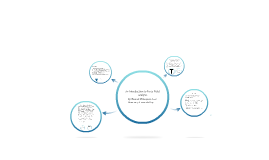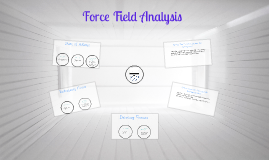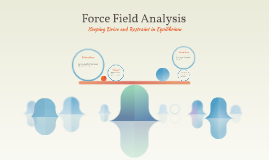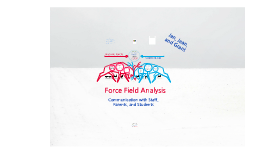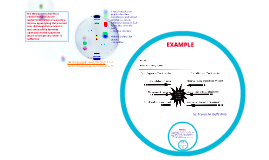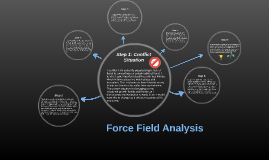Force Field Analysis
Transcript: Process by which we look at the restraining forces that act to keep a problem from changing (social structures, cultural traditions, ideology, politics, lack of knowledge, lack of access to healthy conditions, etc.) and the driving forces that push it toward change (dissatisfaction with the way things are, public opinion, policy change, ongoing public education efforts, existing alternatives to unhealthy or unacceptable activity or conditions, etc.) (Community Tool Box) *Like one big pros and cons list* Research and campaigns to treat those that are infected Steps for Creating the FFA 1) Figure out the goal or change that needs to take place 2) Draw the force field diagram (Desired change in the middle, Driving (Positive) forces on the left, and Restraining (negative) forces on the right 3) Brainstorm list of driving and restraining forces, and put them on the chart. 4) Analyze the driving and restraining forces 5) Assign a number to each driving or restraining force 6)Total up the scores from each column 7) From these scores, determine how feasible reaching your change goal is. Coming back from break on time Created by Kurt Lewin, a social psychologist, created the "Force Field Analysis" in the 1950s as a way to portray the forces affecting a central question or problem. Since its development it has evolved to be used in many different capacities. It can be used in macro social work to understand the forces working with and against a specific community problem or goal. It could also be utilized in micro social work, employed to weigh individual goals/decisions, or to understand the outside forces affecting a person (client). It is used by businesses in making important decisions. For example, whether or not to update to a new system of technology. To work through personal decisions. Your Turn! An Introduction to Force Field Analysis Lack of health education regarding sanitation Restraining Forces How is it Used? An Example from Kenya: The Creation and Use of FFA Berkowitz, B. (2013). Section 5. Analyzing community problems. Retrieved from: http://ctb.ku.edu/en/table-of-contents/assessment/assessing-community-needs-and-resources/analyze-community-problems/main#.UmVKRBbQnzI. Iowa State University Extension and Outreach. (2013). Community and economic development: Force field analysis. Retrieved from: http://www.extension.iastate.edu/communities/force-field-analysis. Kabaka, S., & Kisia, C. W. (2011). National deworming program: Kenya's experience. World Conference on Social Determinants of Health. Rio De Janeiro, Brazil. Kankam, S. (2011). Kenya's national school-based deworming program. Retrieved from: http://ctb.ku.edu/en/3-analyzing-problems-and-goals#exampleFive. Lepori, K. L. (October 2013). [Detailed force field analysis]. Force field analysis-peer collaboration: Building an infrastructure for enhancing technical support. Retrieved from: http://cadres.pepperdine.edu/ar/c11/lepori/Force%20Field.html. Manktelow, J., & Carlson, A. (2013). Force filed analysis: Analyzing the pressures for and against change. Retrieved from: http://www.mindtools.com/pages/article/newTED_06.htm. Skymark Corporation. (2013). Force field analysis. Retrieved from: http://www.skymark.com/resources/tools/force_field_diagram.asp. VectorStudy. (2013). [Diagrams illustrating different forcefiled analyses]. Using Force Field Analysis. Retrieved from: http://vectorstudy.com/management-theories/force-field-analysis. *Lines in the bathroom *Phone calls *Needing to buy coffee or food *Talking with other students *Being unaware of the time By: Hannah McLaughlin, Lisel Neumann, & Amanda May What are the uses of the FFA? Creating a Force Field Analysis for the Community Project: Split up into your community profile groups and create a force field analysis for a specific concern within your community. For example: lack of access to health care limited number of grocery stores limited resources for struggling students What is a Force Field Analysis? FFA Outcome *Trained 16,000 teachers on the de-worming process *Because of this, 3.5 million children recieved treatment *Cost WHO $0.30/child *Wanting to leave class on time *Respect for one another and each other's time *Being ready to get back into the material References Driving Forces Presenting Problem: Researchers with the World Health Organization found that children in Kenya were ill and missing school due to sickness from unsanitary drinking water. 1) Compare ideal situations and reality 2) Assessing strengths and weaknesses of a situation 3) Determine whether or not to go through with a specific project 4) A way to organize ideas Example FFA Insufficient resources in communities, no government policies to combat the issues Development of government policies to provide aid in health, social and economic development






